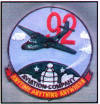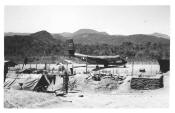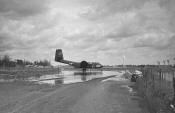|
Viet Cong Attack Caribou 63-9724 (cn 158) at Pleiku Early in the early morning of February 7, 1965, two days before my twenty-sixth birthday, the Viet Cong launched a mortar attack on the MACV compound at Pleiku. At the same time, sappers penetrated the perimeter at Camp Holloway, which was nearby, and placed satchel charges on or near most of the aircraft and at key locations on the airfield. The enemy also lobbed dozens of mortar round into the barracks area. The attacks killed eight Americans and wounded another 104. The flight line was turned into a graveyard of destroyed and heavily damaged fixed and rotary wing aircraft. On February 10, 1965, the hotel in Qui Nhon which housed the members of the 140th Transportation Detachment (our direct support maintenance detachment) was destroyed by a powerful explosive charge, which was placed on the first floor of the building--twenty-seven members of the 140th were killed.Later in the month, enemy mortar rounds heavily bombarded the air base at Ben Hoa. And on March 30, 1965, the U.S. Embassy in Saigon was severely damaged by explosive charges placed by the Viet Cong. Throughout the same period--February and March--enemy attacks against Special Forces camps throughout the country were also increased. The Viet Cong attacks signaled more aggressive actions by the Viet Cong against American installations throughout South Vietnam. The acceleration of the Vietnam War had begun In less than an hour of the attack on Camp Holloway, our platoon's standby airplane, was airborne on its way to Pleiku to help evacuate the scores of seriously wounded to the 8th Field Hospital in Nha Trang. Later that morning my airplane flew to Camp Holloway to fly missions originally assigned to 63-9724, the 1st Flight Platoon's Caribou stationed there. We learned that 63-9724 was damaged in the ground attack and it was out of action, but we did not know how badly it had been damaged. When I saw the airplane I was stunned by the extensive damage it had suffered. There was approximately 20 bullet holes in the right forward portion of the fuselage. Several feet from the airplane, the ground was littered with spent cartridges from an AK-47 assault rifle. It was evident that one of the sappers stood at that location and fired a full 20-round magazine at the airplane. The airplane was also severely damaged by a satchel charge. One of the Special Forces sergeants I talked to that morning gave me his theory of what happened, based on his experience and the evidence at the scene. He sad that the evidence led him to believe that the sapper approached the airplane from the right, fired his AK-47 at the airplane, and then tossed the satchel charge under the airplane. In his haste, he threw the satchel charge so hard that instead of coming to rest beneath the airplane's fuselage, the charge slid or bounced clear of the airplane and then detonated. He pointed out that the darkness may have contributed to the fact that the satchel charge was thrown with too much force because it is more difficult to judge distances when the target is not clearly visible. Originally, there was some disagreement as to the cause of the damage to the Caribou. Some believed that it was done by a mortar round and others said it was done by a satchel charge. The dispute centered around a hole that was blown in the PSP to the left rear of the airplane. The shape of the hole in the PSP, the absence or tears or holes in the airplane--which is common with an exploding mortar round--and the extensive structural damage supported the satchel charge theory. Also, the damage to the right side, which was on the opposite side of the explosion, further supported the satchel charge theory: the satchel charge theory won. The airplane had to be flown to the general support maintenance company in Vung Tau for repair. Vung Tau was approximately 275 miles to the southeast of Pleiku. Temporary repairs had to he made in order to make the airplane airworthy so it could make the flight to Vung Tau. The main gear tires were replaced and some temporary sheet metal repairs had to be made to the airframe. The trusty "green tape" played an important role in the temporary repairs as it-helped cover some of the bullet holes and helped hold temporary cardboard covers over the missing cabin windows. After a couple of days, the airplane was cleared for a one-time flight to Vung Tau. After weeks of extensive maintenance, the damage was repaired, components were replaced, and 63-9724 joined her sisters in the sky over South Vietnam. |
|
| <<< Dan Stelzer and crew of the 51st Trans Det. work
on a 92nd Aviation Co. Caribou engine at Quin Nhon, RVN late 1965.
(Don Wisniewski - Mutza collection) >>> 63-9725 (c/n # 160) getting an engine change at Dalat, Vietnam in 1965. (via Arthur Candenquist) |
||
| <<< 63-9725 (cn # 160) assigned to the 92nd Aviation Company at Kannack in 1965. (AOCA) >>> 63-9727 (cn # 163) assigned to the 92nd Aviation Company at Mue Hoa in 1965. (AOCA) |












